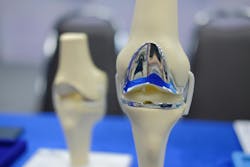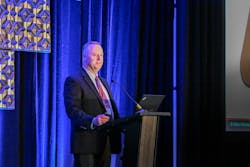How Multiphysics Simulation Accelerates Innovation in Energy, Healthcare & Manufacturing
Key Highlights:
- Multiphysics simulation allows engineers to evaluate complex interactions in a single environment, reducing the need for physical prototypes.
- In healthcare, simulation helped design electromagnetic devices for infection control in knee replacements, securing FDA approval and improving patient outcomes.
- Virtual MRI testing accelerates medical device development by identifying compatibility issues early, saving years in the design cycle.
Many of the problems engineering teams solve today would have been considered nearly impossible just 10 years ago. The availability of multiphysics simulation software has been a game-changer. Using these tools, engineers can now combine thermal, electromagnetic and fluid interactions within a single environment and evaluate design behavior before a prototype is ever built.
Kyle C. Koppenhoefer, PhD, president of AltaSim Technologies, demonstrated the real-world impact of these capabilities through a compelling example. A client developed a novel concept to influence how solar energy is absorbed and re-emitted in Earth’s atmosphere. “The client’s device dealt with the radiation from the sun in a very unique way,” explained Koppenhoefer during an interview at the COMSOL Conference in Boston (Oct. 8-10).
Using COMSOL software, AltaSim simulated how the device responds to solar loading under different atmospheric and geographic conditions. “We were able to simulate how the sun shines on the device, how that device absorbs that radiation, how it reflects that radiation and then what it does with the heat,” Koppenhoefer said.
READ MORE: COMSOL 2025 Highlights Real-World Multiphysics Applications
Although the geometry and functionality remain proprietary under a non-disclosure agreement (NDA), Koppenhoefer said the goal was to determine whether the device could measurably impact radiative heat balance at scale.
“All of that could be done very accurately for any part, any place in the world—we could look at it in Riyadh, we could look at it in Boston,” Koppenhoefer said, adding that they could model this with high accuracy for any location in the world and determine where the device would perform well and where it would not.
Skills & Training: How Manufacturers can Turn Physics into Practical Models
David Jones, vice president of Sales, AltaSim Technologies, said the solar radiation project underscores a common reason clients turn to advanced simulation. Many clients are designing “new-to-the-world products” and want to use advanced capabilities to understand what it’s going to be once fully developed.
“The nice thing about multiphysics is that we can look at multiple impacts on that device or product, all in one software,” Jones said. Simply put, electrical currents, thermal loads and fluid flows can all be co-simulated, and this provides a realistic picture of performance before making the first prototype.
Simulation engineering is a specialized discipline that requires translating complex physics into accurate, real-world models. While tools like COMSOL Multiphysics simplify much of the process, Koppenhoeffer pointed out that one of the biggest challenges simulation engineers face is figuring out how to turn complex physics into practical real-world models.
“It is a special skill that engineers have to learn,” said Koppenhoeffer, adding that AltaSim offers advanced training ranging from full company classes to one-on-one sessions to help organizations develop internal expertise.
Medical Innovation: Tackling Post-Operative Infections
Developing this expertise translates into real-world impact. AltaSim demonstrated this value in healthcare by addressing post-operative infections in knee replacement surgery.
“There are a large number of knee replacements, particularly in the U.S.,” said Koppenhoeffer. “A percentage of those patients experience a substantial infection post op. And that can often mean a second surgery for the patient and substantial delay in their healing.”
The American Association of Hip and Knee Surgeons (AAHKS) states that the risk of infection after a first-time knee replacement in the U.S. is about 1-2%, and higher for revision surgeries.
AltaSim collaborated with a company that developed an innovative solution in the form of an electromagnetic device designed to wrap around the leg and selectively heat the implant to eliminate infection. “But the real trick is to do that without damaging the [surrounding] healthy tissue,” pointed out Koppenhoeffer.
READ MORE: Pocket-Sized Ultrasound: From Medical Device Design to Delivery
And that’s where AltaSim’s simulation expertise proved essential in designing an electromagnetic device that would target the heating of the infection and not damage the healthy tissue. “Through our multiphysics simulation, we were able to represent not only the device, but the actual anatomy and the implant as well, and get a very accurate representation of how that heat is going to distribute in the human body,” explained Koppenhoeffer.
A groundbreaking outcome for the manufacturer in this case was that the simulation enabled them to secure FDA clearance for the patient, explained Jones. This was a novel achievement, he said, as the regulators were confident enough in the results to allow its application in humans. This level of fidelity also demonstrated how advanced multiphysics simulation can directly support regulatory approval.
Virtual MRI Testing: Cutting Years from Development
AltaSim sees similar benefits across other industries, including automotive, aerospace or general industrial, said Jones. “Companies want to understand the manufacturing of that product, how it’s going to perform before it’s ever made because that cuts their time to market down by not just months but sometimes years.”
Mitigating risk early in the design cycle is especially critical in medicine. One of the most transformative applications the biomedical imaging industry has seen is virtual magnetic resonance imaging (MRI) testing for medical devices, said Koppenhoeffer. Fifteen years ago, many implants were not MRI-compatible, often leaving patients with metallic implants restricted from undergoing MRI scans. The procedure can pose hazards for patients with metal implants, such as magnetic forces causing movement, excessive heating from RF energy absorption and image distortions that compromise diagnostic quality.
As the industry began designing MRI compatibility in mind, another challenge persisted. Koppenhoeffer explained that manufacturers would complete the full design cycle only to discover late in the process that the device failed MRI testing, which forced a costly redesign. But today, virtual MRI simulations enable manufacturers to test compatibility early.
With multiphysics simulation, design and application engineers can evaluate MRI compatibility early in development and save years in development time. “Now, with simulation and what we call a virtual MRI machine, you’re able to virtually test any design concept and see if it’s going to be MRI compatible,” said Koppenhoeffer. “If it is, you can continue the design process and that can seriously take years out of the design cycle of a medical device.”
Emerging Trends in Simulation
Two trends are shaping the future of engineering design, according to Koppenhoeffer. The first is “uncertainty quantification,” where material properties and other inputs often vary during operation and introduce uncertainty into simulations. Quantifying this variability is becoming increasingly important for accurate predictions, Koppenhoeffer said, as it helps the design team better understand parameters, from material properties to boundary conditions to extreme challenges.
READ MORE: Simulation Aids in Product Development and Design Across Industries
The second trend is the prevalence of Simulation Applications. Tools like COMSOL simplify complex simulations by wrapping them in user-friendly interfaces, he said. These apps allow non-experts to input accessible data and run advanced physics calculations. They are then able to deliver actionable insights such as cost savings without requiring deep technical knowledge.
A Concrete Method for Bringing Simulation to the Field
The push to make simulation accessible to engineers—and not just analysts—featured prominently at the COMSOL conference in Boston, where simulation apps were widely discussed.
Koppenhoeffer noted, “At AltaSim, we can develop custom apps that connect directly with COMSOL. These apps can be used by engineering teams to input data or even deployed in the field.”
Concrete manufacturing is an industry that’s not typically associated with advanced simulation. Workers preparing to mix concrete can use the app to enter conditions such as temperature and environmental factors at the construction site and the COMSOL app will then calculate the optimal concrete mix for those conditions, Koppenhoeffer said.
“And so, these little things, where simulation is getting into industry, are making a huge difference,” he said.
About the Author

Rehana Begg
Editor-in-Chief, Machine Design
As Machine Design’s content lead, Rehana Begg is tasked with elevating the voice of the design and multi-disciplinary engineer in the face of digital transformation and engineering innovation. Begg has more than 24 years of editorial experience and has spent the past decade in the trenches of industrial manufacturing, focusing on new technologies, manufacturing innovation and business. Her B2B career has taken her from corporate boardrooms to plant floors and underground mining stopes, covering everything from automation & IIoT, robotics, mechanical design and additive manufacturing to plant operations, maintenance, reliability and continuous improvement. Begg holds an MBA, a Master of Journalism degree, and a BA (Hons.) in Political Science. She is committed to lifelong learning and feeds her passion for innovation in publishing, transparent science and clear communication by attending relevant conferences and seminars/workshops.
Follow Rehana Begg via the following social media handles:
X: @rehanabegg
LinkedIn: @rehanabegg and @MachineDesign

